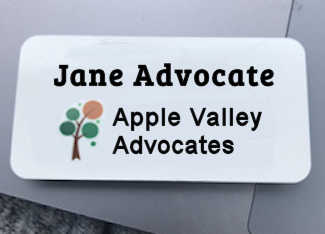Years ago I was invited to present a talk on Patient-Doctor Communications to a group of specialists. I was just one speaker during a many-day conference for thousands of doctors who had come in from all over the world.
Imagine my surprise when I was assigned to a large room, set up for 300 or more attendees. And imagine my even bigger surprise when it was standing room only! What on earth? Me? Why would so many people care what I had to say?*
The even bigger surprise came about as I began speaking. I was setting the stage for them to walk into the exam room where the patient was waiting, with two pieces of advice: First, that they check that their nametags were turned out so the patient could read them (because, you know how often then are turned backwards and can’t be read?) And second, that they NOT be reading a chart or paperwork as they walk into the room. Instead they should look their patient in the eye, then introduce themselves, “Hello. I’m Dr. So-and-So,” then wait for a moment while the patient replied with her or his name.
The surprise? That, immediately, half the attendees wrote that down! I watched them as their heads bowed to their notes and their pens began in earnest to record my words. I was floored.
This story came to mind recently when I took a friend to see a specialist who did neither of those things. His nametag was turned and unreadable, and he was reading the chart as he walked through the door. He finally looked up, never introducing himself, and said “Are you Francine?” Then he started in with questions.
I interrupted him. “Excuse me. Who are you?” He was clearly taken aback. He was dressed in some generic scrubs. How would we know? He looked down at his nametag, as if to point at it, when he realized it could not be read. So he introduced himself.
He maintained an arrogant air throughout the appointment. The entire tenor of the appointment never improved. Now Francine wants to find another doctor. I can’t blame her.
… which leads me to today’s TIP.
Are we advocates and care managers in danger of being considered so arrogant too? Do we make assumptions about someone else’s regard like that specialist did?
When you meet a new client, or attend an appointment, or sit by a hospital bedside, are you wearing a name tag? Is it attached to your body so it can always be read? Do you immediately stand up when someone arrives to introduce yourself? Or do you assume everyone knows who you are?
Today’s TIP is so very simple, and should become everyone’s habit. NEVER assume the people in the room know who you are.
 Whenever you are doing business, wear a nametag. Make sure both the tag itself, and typeface with your name are LARGE and BOLD enough to be read at some distance. Brand it with your logo! It will look very professional, it will set you apart, and it will reek of importance – all good! (Hint: the magnetic ones are great because they can’t turn around and they don’t leave holes in your shirt.)
Whenever you are doing business, wear a nametag. Make sure both the tag itself, and typeface with your name are LARGE and BOLD enough to be read at some distance. Brand it with your logo! It will look very professional, it will set you apart, and it will reek of importance – all good! (Hint: the magnetic ones are great because they can’t turn around and they don’t leave holes in your shirt.)
Further, never assume someone knows your name. Even if you have met before, state your name. If they say, “Of course, we’ve met before” – no problem. A reminder is always appreciated. If you can (meaning, if no one is concerned about spreading infection), then reach out to shake hands. If you are meeting a doctor alongside a client, then speak your name AND state your purpose for being there. “Good afternoon, Dr. So-and-So. I’m Jane Advocate, and I’m here to help Mrs. Client understand and remember today’s discussion with you about her diagnosis.” If you have a brochure to leave behind, this is a good time to provide it. This is also a good time to mention you plan to record the conversation.
No guessing! It sets the stage for a respectful and fruitful conversation.
*Why were there so many attendees at my presentation? It turns out they were earning CMEs (continuing credits) and there was an electronic check-in system in use. They had to scan the barcode on their conference nametags – in, and out. I had a captive audience! THAT explained it!
Like PUP! TIPS?
Subscribe to find a new tip in your inbox twice a month! Sign Up for TIPS
Sign Up for TIPS


I get referrals from physicians now because I introduce myself, become a part of the team for my client and show that I also have the best interest of their patient and that we can all work together to help this person. I have left business cards at Physical Therapists offices too and gotten calls.
It’s important to show deferrence to the provider while calmly discussing options and possible treatments. They are more likely to include you and listen to you and your client